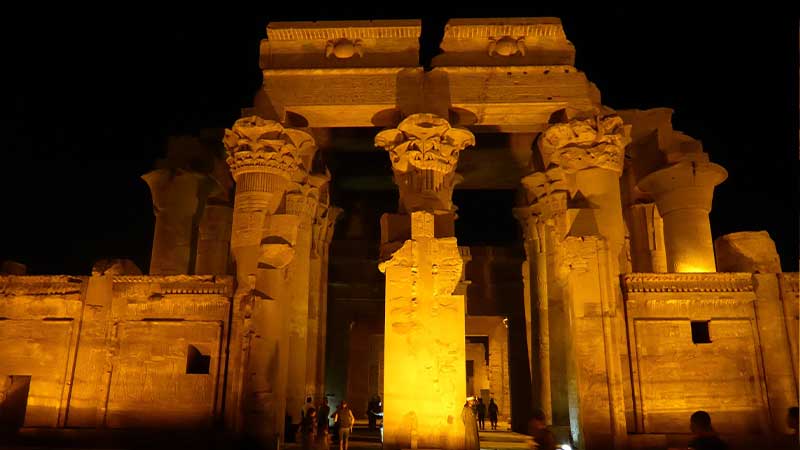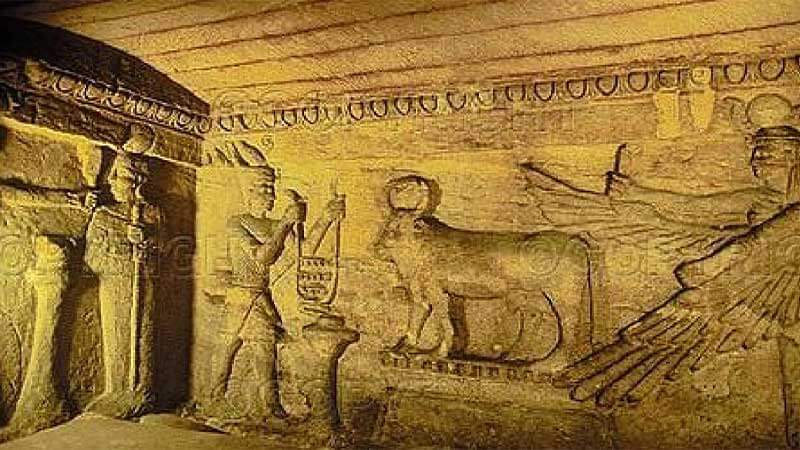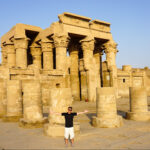Step into the realm of ancient Egyptian spirituality and marvel at the architectural brilliance of the Temple of Kom Ombo, Which is next to Edfu Temple. This awe-inspiring monument, nestled on the banks of the majestic Nile River, offers a captivating glimpse into the past. As you journey through this article, you will explore the temple virtually, delving into its historical context, intricate details, and the enigmatic dual worship it represents.
Unveiling the Wonders: Exploring the Temple of Kom Ombo
The Temple of Kom Ombo is a testament to ancient Egypt’s dualistic religious beliefs, dedicated to two powerful deities: Sobek, the crocodile god, and Horus, the falcon-headed god. This extraordinary architectural marvel seamlessly integrates two temple complexes within its structure, each dedicated to one of these deities.
A Dual Sanctuary: Sobek and Horus
At the heart of the temple lies a unique arrangement – two symmetrical sections mirroring each other, with separate courtyards and sanctuaries. The left side is dedicated to Sobek, symbolizing fertility and protection, while the proper side honors Horus, associated with kingship and the sky.
Architectural Symmetry and Significance
The temple’s meticulous design reflects the ancient Egyptians’ profound understanding of balance and symmetry. The alignment of the structures with celestial bodies underscores the spiritual connection between the earthly realm and the cosmos. This architectural precision also served ritualistic purposes, ensuring the performance of ceremonies with utmost accuracy.
Hieroglyphs that Whisper Secrets
The temple walls are adorned with intricate hieroglyphic inscriptions, offering a wealth of knowledge about the era’s beliefs, customs, and daily life. These inscriptions provide insights into medical practices, agricultural techniques, and even mythical stories, granting modern historians invaluable glimpses into the past.
Astronomical Alignments: Navigating the Skies
Among the temple’s captivating features are its celestial alignments. The temple’s axis is carefully aligned with the sunrise during significant days, such as the summer solstice. This alignment underscores the ancient Egyptians’ deep connection to astronomical phenomena and their integration into religious practices.

Decoding the Dual Worship: Sobek and Horus
The dualistic nature of the Temple of Kom Ombo invites us to explore the significance of both Sobek and Horus within the ancient Egyptian pantheon.
Sobek: The Crocodile Deity
Sobek, often depicted as a crocodile or a man with a crocodile head, held a multifaceted role in ancient Egyptian beliefs. He was revered as a protective deity, safeguarding against the dangers of the Nile while also embodying the Nile’s fertile and life-giving qualities. The temple’s proximity to the river further emphasizes Sobek’s significance in this region.
Horus: The Falcon God
Horus, symbolized by a majestic falcon, represented divine kingship and protection. As the son of Osiris and Isis, his mythological narrative resonated deeply with concepts of resurrection and eternal life. The temple’s dedication to Horus highlights the importance of this deity in the hearts of ancient Egyptians.
Archaeological Insights: Unearthing the Past
The Temple of Kom Ombo continues to be a treasure trove for archaeologists and historians, offering a glimpse into ancient Egypt’s religious practices and societal dynamics.
- Medical Marvels and Healing Rituals
Among the temple inscriptions are depictions of medical instruments and techniques, shedding light on the medical knowledge of the time. The temple served as a center for healing rituals, where pilgrims sought cures for various ailments through spiritual and practical means.
- Offering to the Gods: A Ritualistic Journey
The temple’s corridors and chambers reveal insights into the rituals and ceremonies conducted by priests and devotees. Elaborate offerings and ceremonies were performed to honor the deities and seek their blessings. The alignment of the temple with celestial events added a layer of cosmic significance to these rituals.

FAQs About the Temple of Kom Ombo
What is the significance of the dual design of the Temple of Kom Ombo?
The dual design symbolizes the coexistence of two deities – Sobek and Horus – highlighting their distinct yet interconnected roles in ancient Egyptian beliefs.
How old is the Temple of Kom Ombo?
The temple dates back to the Ptolemaic period, around the 2nd century BCE, with later Roman additions.
Can visitors explore the interior of the temple?
Visitors can explore the temple’s intricate chambers, halls, and sanctuaries adorned with fascinating hieroglyphs and reliefs.
What is the role of celestial alignments in the temple?
Celestial alignments served ceremonial and symbolic purposes, connecting the temple’s ceremonies with astronomical events and the divine realm.
Is there a museum or exhibition at the temple site?
Yes, the temple complex features a museum displaying artifacts unearthed from the site, offering a deeper understanding of its historical context.
How does the Temple of Kom Ombo reflect ancient Egyptian medical knowledge?
The temple’s inscriptions depict medical instruments and practices, shedding light on the medical expertise of the time and its integration with religious rituals.
Conclusion
The Temple of Kom Ombo stands as a testament to ancient Egyptian civilization’s ingenuity, spirituality, and artistic prowess. Its dual worship, intricate architecture, and celestial alignments provide a window into the rich tapestry of beliefs that shaped this remarkable culture. As you stand before the temple’s grandeur or explore its sacred chambers, let the whispers of history and the echoes of ancient rituals transport you to a bygone era, where gods and mortals converge in reverence and awe.




